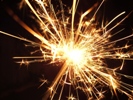
Safely Lighting the Fourth
Burns and lacerations to the hands, face, and head were the most commonly reported consumer injuries in 2010, according to the U.S. Consumer Product Safety Commission.
- By Jerry Laws
- Jul 01, 2012
Professional fireworks shows are certainly safer than setting off your own rockets, fountains, etc. For consumers where fireworks sales are allowed, the U.S. Consumer Product Safety Commission and the Pyrotechnics Guild International, Inc.'s fireworks safety guidelines offer some advice for handling and discharging them safely.
The latter organization will hold its 2012 convention Aug. 11-17 at the LaPorte County Fairgrounds in LaPorte, Ind. Its Official Fireworks Safety Guidelines were updated last year and are in effect during its conventions. Its guidelines are clearly intended for professionals working with pyrotechnics, and they are guided by NFPA 1123 (Code for Fireworks Display, currently in its 2010 edition), and NFPA 1126 (Standard for the Use of Pyrotechnics Before a Proximate Audience, currently in its 2011 edition). However, some of the requirements of the PGI guidelines inform consumers' use of fireworks, such as prohibiting anyone "who is acting in an irresponsible manner or appears to be under the influence of alcohol of other drugs" from handling or discharging any fireworks. In addition, the guidelines state that all personnel engaged in discharging fireworks should wear protective clothing, safety glasses, ear plugs, and hard hats.
OSHA offers a topics page about hazards to which workers in the pyrotechnics industry are frequently exposed. The page was developed through an earlier alliance with the American Pyrotechnics Association. "As we look forward to celebrating July 4 with fireworks and festivities, we must also consider the safety of workers who handle pyrotechnics," OSHA Assistant Secretary Dr. David Michaels said in a June 27 news release. "It's the employer's responsibility to keep everyone safe on the job and take appropriate measures to protect workers making, selling, displaying, or otherwise handling dangerous pyrotechnic materials."
The U.S. Consumer Product Safety Commission reported in June 2011 that about 8,600 people in the United States went to emergency rooms during 2010 after being injured in connection with consumer fireworks (both legal and illegal fireworks). CPSC's annual death and injury report on fireworks also indicates about 40 percent of the estimated injuries occurred to children younger than 15. Burns and lacerations to the hands, face, and head were the most common injuries, and about 40 percent of the injuries were related to products generally considered harmless -- firecrackers, bottle rockets, and sparklers, which the agency says burn at a temperature of about 2,000 degrees.
CPSC recommends following these safety steps:
- Don't allow young children to play with or ignite fireworks.
- Avoid buying fireworks packaged in brown paper because this is often a sign that the fireworks were made for professional displays and could be dangerous to consumers.
- Always have an adult supervise fireworks activities.
- Never place any part of your body directly over a fireworks device when lighting the fuse. Back up to a safe distance immediately after lighting fireworks.
- Never try to re-light or pick up fireworks that have not ignited fully.
- Never point or throw fireworks at another person.
- Keep a bucket of water or a garden hose handy in case of fire or other mishap.
- Light fireworks one at a time, then move back quickly.
- Never carry fireworks in a pocket or shoot them off in metal or glass containers.
- After fireworks complete their burning, douse the spent device with plenty of water from a bucket or hose before discarding it to prevent a trash fire.
- Make sure fireworks are legal in your area before buying or using them.
The National Fire Protection Association's latest Fireworks Report said an estimated 15,500 reported fires were started by fireworks in 2010, and more fires occur on a typical Fourth of July than any other day of the year. Fireworks account for 40 percent of the fires, more than any other cause of fires that day.
About the Author
Jerry Laws is Editor of Occupational Health & Safety magazine, which is owned by 1105 Media Inc.